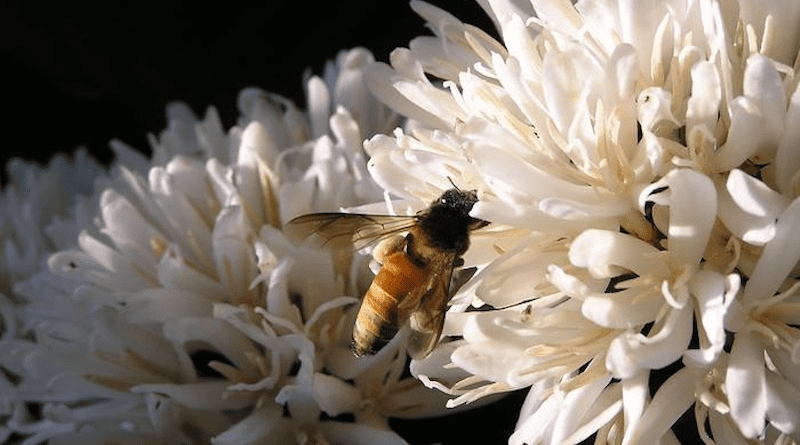More Work Needed To Unlock Mysteries Of Asia’s Bees
Although the collapse of hives of European honey bees (Apis mellifera) has gained worldwide attention in recent years, there are massive gaps in knowledge of other bee species, particularly in the Asian region, which contains over half the world’s human population and where food security (in which bees play a key role) remains a major challenge.
According to a recent global analysis, only 1% of the global public data on bee distribution comes from Asia, even though 15% of the world’s bee species are thought to live there.
In a new paper, “Opportunities and challenges in Asian bee research and conservation”, published in the journal Biological Conservation, 74 researchers from various regions including 13 Asian countries strongly recommend that more resources be put to building basic scientific knowledge of bee biodiversity throughout Asia.
Dr. Smitha Krishnan, co-author of the paper and a researcher at the Alliance of Bioversity International and CIAT, based in Bengaluru, India, said the biggest impediment to preserving bee species is a lack of knowledge of what we have, where and how species live, and even more foundationally an inability to identify different species.
“Given the key roles native bees play, both ecologically and economically in a region like Asia, understanding how to manage and maintain bee diversity is crucial for our food and nutritional security and resilience of forests, thus the multiple ecosystem services that the forests provide which are vital for our survival,” Krishnan said, adding that a diverse range of bees are needed to cater to the wide diversity of flower types that need to be pollinated, especially in agriculture.
“For example,I worked on coffee pollination for my PhD and we found that three different social bees contributed majorly towards the pollination of coffee,” Krishnan said.
Better Knowledge of Asian Bees
John S. Ascher, a co-author of the study and an associate professor at the National University Singapore and Asia region lead of the IUCN Wild Bee Specialist Group explained that very little is known about the status of Asian bee species since a large proportion of regional species, especially the endemics (those restricted to Asia) of greatest conservation importance have little or no public data.
“Much of this information is scattered hence the need to consolidate our ideas, knowledge, and plans,” he said, adding that this is especially true of ecosystem services like pollination of crops, since there are many local studies of particular crops at scattered sites, but not a good understanding of region-wide patterns.
“One problem is that the bees themselves are very poorly known and very few experts are available to identify them, thus much information about function that does exist is not at species level, limiting its utility and preventing reliable generalizations across sites,” Ascher said.
In 2014, the IUCN published a Red List of bees in Europe, highlighting the conservation status of bee species there, but no similar publication yet exists for Asian bee species.
Michael Orr, an Assistant Professor at the Chinese Academy of Sciences in Beijing and a co-author of the paper, explained that basic knowledge on how bees live in Europe is often taken for granted, but it’s immensely difficult to even identify bees from most parts of Asia to species.
“Virtually no Asian bees have been assessed for their conservation status, making it exceedingly difficult for local researchers and conservationists to recommend protections,” Orr said, “Similarly, for most crops, we don’t yet know their most important pollinators, which is crucial given food security needs across much of the region.”
Collaboration Key For Future Studies
Natapot Warrit, currently an assistant professor and researcher at Chulalongkorn University in Bangkok, Thailand and a key author of the paper said that collaborations among researchers and local taxonomic inventories in different countries are the key to future success to shed light on the diversity and importance of these pollinators.
“We need to know where they are before we can protect them. As soon as we get the data in somewhat decent shape, then we can start assessing their red-listing condition to learn more about their vulnerabilities to extinction,” Warrit said.
Krishnan explained that for these efforts to achieve their maximum potential, conservation efforts must also be multi-disciplinary.
“Trans-border partnerships must be central to future efforts; given the complex political dynamics of the region, science and research can help mend some of these divisions, but more open sharing of specimens and data will be key,” she said.
On a personal level, Krishnan hopes these efforts pay off.
“I am intrigued by the fact that these tiny insects play such a crucial role in our food and nutritional security and resilience of forests and thus the multiple ecosystem services that are crucial for our survival.”

